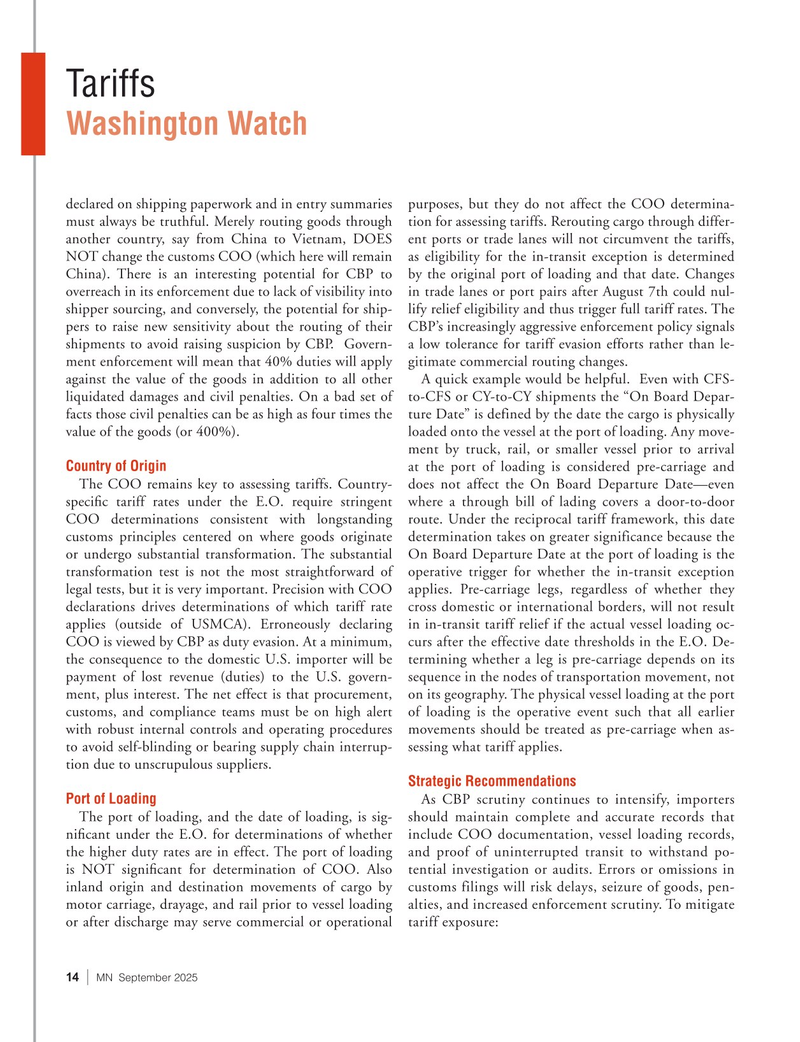
Page 14: of Marine News Magazine (September 2025)
Read this page in Pdf, Flash or Html5 edition of September 2025 Marine News Magazine
Tariffs
Washington Watch declared on shipping paperwork and in entry summaries purposes, but they do not affect the COO determina- must always be truthful. Merely routing goods through tion for assessing tariffs. Rerouting cargo through differ- another country, say from China to Vietnam, DOES ent ports or trade lanes will not circumvent the tariffs,
NOT change the customs COO (which here will remain as eligibility for the in-transit exception is determined
China). There is an interesting potential for CBP to by the original port of loading and that date. Changes overreach in its enforcement due to lack of visibility into in trade lanes or port pairs after August 7th could nul- shipper sourcing, and conversely, the potential for ship- lify relief eligibility and thus trigger full tariff rates. The pers to raise new sensitivity about the routing of their CBP’s increasingly aggressive enforcement policy signals shipments to avoid raising suspicion by CBP. Govern- a low tolerance for tariff evasion efforts rather than le- ment enforcement will mean that 40% duties will apply gitimate commercial routing changes.
against the value of the goods in addition to all other A quick example would be helpful. Even with CFS- liquidated damages and civil penalties. On a bad set of to-CFS or CY-to-CY shipments the “On Board Depar- facts those civil penalties can be as high as four times the ture Date” is defined by the date the cargo is physically value of the goods (or 400%). loaded onto the vessel at the port of loading. Any move- ment by truck, rail, or smaller vessel prior to arrival
Country of Origin at the port of loading is considered pre-carriage and
The COO remains key to assessing tariffs. Country- does not affect the On Board Departure Date—even speci? c tariff rates under the E.O. require stringent where a through bill of lading covers a door-to-door
COO determinations consistent with longstanding route. Under the reciprocal tariff framework, this date customs principles centered on where goods originate determination takes on greater significance because the or undergo substantial transformation. The substantial On Board Departure Date at the port of loading is the transformation test is not the most straightforward of operative trigger for whether the in-transit exception legal tests, but it is very important. Precision with COO applies. Pre-carriage legs, regardless of whether they declarations drives determinations of which tariff rate cross domestic or international borders, will not result applies (outside of USMCA). Erroneously declaring in in-transit tariff relief if the actual vessel loading oc-
COO is viewed by CBP as duty evasion. At a minimum, curs after the effective date thresholds in the E.O. De- the consequence to the domestic U.S. importer will be termining whether a leg is pre-carriage depends on its payment of lost revenue (duties) to the U.S. govern- sequence in the nodes of transportation movement, not ment, plus interest. The net effect is that procurement, on its geography. The physical vessel loading at the port customs, and compliance teams must be on high alert of loading is the operative event such that all earlier with robust internal controls and operating procedures movements should be treated as pre-carriage when as- to avoid self-blinding or bearing supply chain interrup- sessing what tariff applies.
tion due to unscrupulous suppliers.
Strategic Recommendations
Port of Loading As CBP scrutiny continues to intensify, importers
The port of loading, and the date of loading, is sig- should maintain complete and accurate records that ni? cant under the E.O. for determinations of whether include COO documentation, vessel loading records, the higher duty rates are in effect. The port of loading and proof of uninterrupted transit to withstand po- is NOT signi? cant for determination of COO. Also tential investigation or audits. Errors or omissions in inland origin and destination movements of cargo by customs filings will risk delays, seizure of goods, pen- motor carriage, drayage, and rail prior to vessel loading alties, and increased enforcement scrutiny. To mitigate or after discharge may serve commercial or operational tariff exposure: 14 | MN September 2025

 13
13

 15
15
